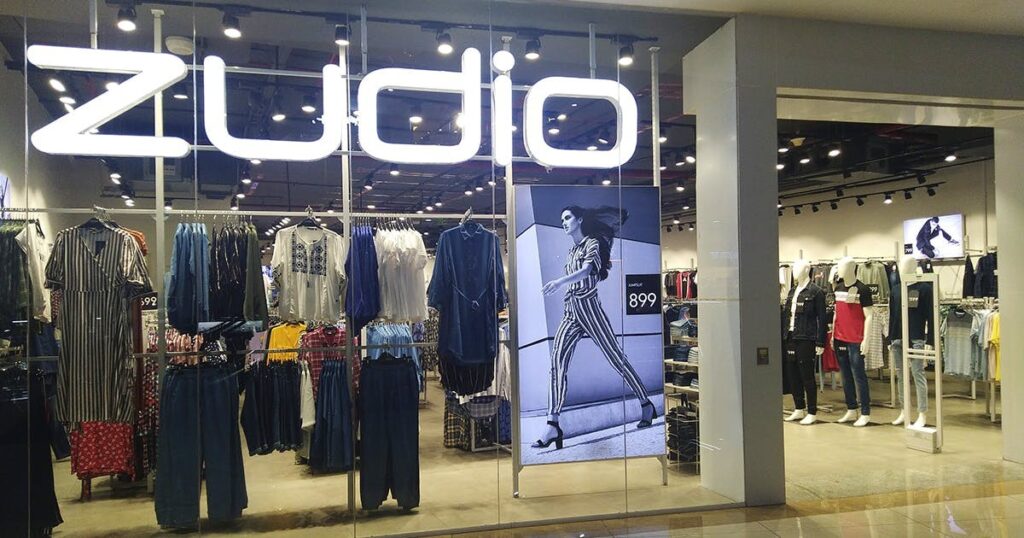Introduction
Zudio, a retail brand under Trent Limited, a part of the Tata Group, has rapidly emerged as a leader in the Indian fashion industry. Launched in 2016, Zudio offers a wide range of trendy clothing, footwear, and accessories at highly affordable prices. Unlike premium brands like H&M, Zara, and Allen Solly, Zudio’s products are accessible to a broader demographic, particularly in Tier 2 and Tier 3 cities across India. This case study explores how Zudio has managed to conquer the Indian fashion market with its unique pricing model, strategic market positioning, and efficient business operations.
Market Opportunity and Strategy
India’s fashion market, especially in smaller cities, has long been characterized by a gap between high-end international brands and local, often unbranded, options. Recognizing this gap, Zudio strategically positioned itself as a value fashion brand catering to young, budget-conscious consumers who seek trendy yet affordable clothing. With over 60% of India’s population being young and middle-class, Zudio tapped into a segment eager for quality and fashion-forward products but unable or unwilling to pay premium prices.
Business Model
Zudio’s success can be attributed to its robust and efficient business model, designed to keep costs low while delivering value to consumers. The key components of this model include:
1. Fast-Fashion Approach:
Zudio follows a fast-fashion model, producing trendy clothing in bulk. This allows the brand to take advantage of economies of scale, reducing per-unit costs and enabling competitive pricing.
2. Cost-Efficient Production:
Zudio sources raw materials from low-cost suppliers and employs cost-efficient production methods. This approach is complemented by a lean supply chain, which leverages the Tata Group’s extensive logistics network to minimize operational expenses.
3. Minimal Marketing Expenditure:
Unlike many competitors, Zudio spends virtually nothing on traditional advertising. The brand does not engage in celebrity endorsements or high-profile ad campaigns. Instead, it relies on word-of-mouth and influencer marketing to reach its target audience, further reducing costs.
4. Direct Sourcing:
Zudio eliminates middlemen by sourcing products directly from factories. This direct-to-retail approach cuts down on additional costs typically associated with intermediaries, allowing Zudio to offer lower prices to consumers.
5. High-Volume, Low-Margin Sales:
Zudio’s profitability comes from its focus on high-volume sales. By offering products at low prices, the brand appeals to a large customer base, ensuring a high turnover of products. This strategy allows Zudio to maintain its profitability despite operating on low margins.
Why Did Zudio Become So Famous in Such a Short Time?
Zudio’s meteoric rise in the Indian fashion market can be attributed to several key factors:
1. Understanding the Market Need:
Zudio identified a significant gap in the market: the need for affordable, trendy fashion among the young, middle-class population in smaller cities. By catering directly to this underserved segment, Zudio quickly gained popularity.
2. Affordable Pricing:
Zudio’s competitive pricing model, with products ranging from ₹99 to ₹999, made fashion accessible to a wide audience. This affordability, combined with the perception of quality and trendiness, resonated strongly with cost-conscious consumers.
3. Rapid Expansion:
Within just a few years, Zudio expanded its presence across India, opening more than 130 stores. This rapid growth ensured that the brand was visible and accessible to a large number of consumers, further boosting its popularity.
4. Word-of-Mouth Marketing:
Despite not investing heavily in traditional advertising, Zudio managed to create buzz through word-of-mouth and influencer marketing. Satisfied customers became brand ambassadors, spreading the word about Zudio’s value proposition.
5. Appeal to Youth:
Zudio’s focus on trendy, youthful designs helped it connect with young consumers who are always on the lookout for the latest fashion at affordable prices. This connection with youth culture played a significant role in Zudio’s quick rise to fame.
6. Strategic Store Locations:
By focusing on Tier 2 and Tier 3 cities, where competition from high-end brands was minimal, Zudio was able to establish a strong foothold in these markets. This strategic move allowed the brand to dominate in areas that were previously underserved by the fashion industry.
Market Penetration and Expansion
Zudio has successfully penetrated the Indian market by focusing on Tier 2 and Tier 3 cities, which are often underserved by high-end fashion brands. By setting up stores in these developing cities, Zudio has tapped into a growing demand for affordable fashion. The brand’s pricing strategy, with products typically ranging from ₹99 to ₹999, has made fashion accessible to a broader audience, fostering customer loyalty and repeat business.
Currently, Zudio operates more than 130 stores across India, with plans for further expansion. The brand’s focus on smaller cities has not only allowed it to capture a significant share of the market but also positioned it as a go-to brand for budget-conscious consumers.
Trent Limited’s Strategic Growth and Expansion: Key Highlights

Trent Limited has strategically focused on cautious and measured growth, prioritizing quality over quantity. From 2000 to 2017, the company opened an average of just seven Westside stores annually, reflecting its disciplined approach.
- Zudio’s Launch and Expansion: For Zudio, Trent leveraged the existing infrastructure of Star supermarkets, carefully assessing product viability before launching the first independent Zudio store in FY18.
- Store Economics: This meticulous approach resulted in low store closure rates, consistent sales per square foot, and a strong return on capital employed (ROCE).
- Rapid Growth: Between FY18 and FY23, Trent accelerated its expansion, tripling its store count from 147 to 566 within five years.
- Revenue Surge: This rapid expansion significantly boosted revenue, with a robust compound annual growth rate (CAGR) of 34% over the last five years, and revenue doubling in the past year to ₹8,242 crore.
- Operational Excellence: Despite the fast-paced growth, Trent maintained strong profitability through sharp operational execution, an increased focus on private label merchandise, a tightly controlled supply chain, and a growing base of loyal customers.
- Financial Health: Financially, Trent has continued to thrive, maintaining profit margins and a healthy cash conversion cycle, demonstrating efficient management of its working capital and sustained financial stability.
Customer-Centric Approach
Zudio’s success is not just about low prices. The brand has managed to create a strong emotional connection with its customers by understanding their needs and preferences. By offering trendy, high-quality products at affordable prices, Zudio has positioned itself as a brand that resonates with the aspirations of young Indians.
Conclusion
Zudio’s rapid rise in the Indian fashion market is a testament to the effectiveness of its business model. By combining a fast-fashion approach with cost-efficient production, minimal marketing expenses, direct sourcing, and a focus on high-volume sales, Zudio has managed to offer stylish, affordable fashion to a broad segment of the population. The brand’s success in Tier 2 and Tier 3 cities highlights the untapped potential in these markets and serves as a model for other brands looking to penetrate similar markets.
Zudio’s ability to provide trendy fashion at affordable prices has not only disrupted the Indian fashion industry but also established the brand as a leader in value fashion. As Zudio continues to expand its footprint across India, its innovative approach to pricing and market penetration will likely continue to drive its growth and success in the years to come.
FAQ: The Success Story of Zudio – How Affordable Fashion Conquered India in Record Time
1. What is Zudio, and who owns the brand?
- Zudio is a value fashion retail brand that offers trendy clothing, footwear, and accessories at affordable prices. The brand is owned by Trent Limited, a part of the Tata Group, one of India’s largest conglomerates.
2. When was Zudio launched?
- Zudio was launched in 2016 in India as a fast-fashion brand.
3. How does Zudio manage to offer such low prices on its products?
- Zudio keeps prices low by leveraging a fast-fashion model, cost-efficient production methods, direct sourcing from factories, and minimal marketing expenses. The brand also focuses on high-volume sales, which allows it to maintain profitability despite low margins.
4. Why did Zudio become so famous in such a short time?
- Zudio quickly became famous due to its strategic focus on offering affordable, trendy fashion to a young, budget-conscious audience, particularly in Tier 2 and Tier 3 cities. The brand’s rapid expansion, word-of-mouth marketing, and understanding of the Indian market needs contributed significantly to its success.
5. What are the key factors behind Zudio’s success in the Indian fashion market?
- Zudio’s success can be attributed to several factors, including its affordable pricing model, fast-fashion approach, efficient supply chain, minimal marketing costs, and focus on high-volume sales. Additionally, its strategic location in smaller cities and understanding of the Indian middle-class market played crucial roles.
6. How many Zudio stores are there in India?
- As of now, Zudio operates more than 130 stores across India, with plans for further expansion.
7. Does Zudio collaborate with celebrities for marketing?
- No, Zudio does not collaborate with celebrities or invest in traditional advertising. The brand relies on word-of-mouth and influencer marketing, which helps keep costs low.
8. What makes Zudio different from other fashion brands like H&M or Zara?
- Unlike premium fashion brands like H&M and Zara, Zudio focuses on offering trendy fashion at much lower prices, making it accessible to a wider audience, particularly in smaller Indian cities. Zudio also adopts a leaner business model with minimal marketing and direct sourcing, further distinguishing it from these global brands.
9. What is Zudio’s target market?
- Zudio primarily targets young, middle-class consumers in India who are looking for fashionable clothing at affordable prices. The brand is especially popular in Tier 2 and Tier 3 cities, where high-end fashion options are limited.
10. What are the typical price ranges for products at Zudio?
- Zudio’s products are typically priced between ₹99 and ₹999, making them highly affordable compared to other fashion brands.




